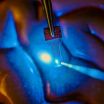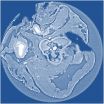(Press-News.org) (SALT LAKE CITY)—Workers punching in for the graveyard shift may be better off not eating high-iron foods at night so they don't disrupt the circadian clock in their livers.
Disrupted circadian clocks, researchers believe, are the reason that shift workers experience higher incidences of type 2 diabetes, obesity and cancer. The body's primary circadian clock, which regulates sleep and eating, is in the brain. But other body tissues also have circadian clocks, including the liver, which regulates blood glucose levels.
In a new study in Diabetes online, University of Utah researchers show that dietary iron plays an important role in the circadian clock of the liver. Judith A. Simcox, Ph.D., a University of Utah postdoctoral fellow in biochemistry, is the study's lead author.
"Iron is like the dial that sets the timing of the clock," Simcox says. "Discovering a factor, such as iron, that sets the circadian rhythm of the liver may have broad implications for people who do shift work."
Each of the body's circadian clocks operates on its own schedule to perform its necessary functions. The circadian clock in the brain, for example, is set by light, telling people to wake up in the morning and sleep when it's dark. Ideally all the body's clocks would work on their correct schedules. But, as anyone who has ever been on a graveyard or swing shift knows, working off-hours can cause one's circadian clocks to get out of synch and disrupt sleeping and eating patterns.
Numerous studies have found that shift workers experience higher incidences of obesity, diabetes and other metabolic disorders. The risk for cardiovascular disease, stroke and cancer also is higher among those workers. In 2007, a World Health Organization subcommittee declared that shift work is probably carcinogenic.
External Signals
The liver's circadian clock is set by food intake. As people sleep this clock helps maintain a constant blood glucose level, but then causes it to spike just before they wake up. When the clock in the liver gets out of synch with the one in the brain, it may contribute to metabolic diseases, according to Donald A. McClain, M.D., Ph.D., University of Utah professor of medicine (endocrinology) and biochemistry and senior author on the study.
McClain and Simcox wanted to identify external signals that set the circadian clock in the liver. They fed iron to mice as part of their natural eating cycle and observed that dietary iron increases the cellular concentration of heme, an oxygen-carrying iron compound found in hemoglobin. They found that when heme binds to a circadian protein–a substance whose function Simcox likens to that of a cog in a mechanical clock–the protein's activity increases and causes the liver to optimally control blood glucose levels.
Increased activity of a circadian protein is healthy when it occurs in the liver's natural clock cycle. But if this happens at a time that is out of synch with the circadian clock, such as during a graveyard shift, it could result in abnormal blood glucose levels.
"When a shift worker eats foods high in iron at night it could exacerbate the lack of synchronization between the clock in the liver and the main one in the brain," says McClain, who's also the University Health Sciences' associate vice president for clinical research and director of the Center for Clinical and Translational Science. "By tending to flatten the circadian variation of metabolism, high iron in tissues may also interfere with the normal day to night fluctuations associated with a healthy metabolic system."
More research is needed to see how the results of their study could affect dietary recommendations for everyone, and shift workers in particular. The investigators are quick to point out that too little iron is also unhealthy. Ultimately, they hope their studies define an optimal range of iron that is much narrower than the current "normal" range.
INFORMATION:
Researchers from the University of Utah's Departments of Medicine and Biochemistry and the Veterans Administration Research Service at the V.A. Salt Lake City Health System also contributed to the study.
DURHAM, N.H. –- Crewed missions to Mars remain an essential goal for NASA, but scientists are only now beginning to understand and characterize the radiation hazards that could make such ventures risky, concludes a new paper by University of New Hampshire scientists.
In a paper published online in the journal Space Weather, associate professor Nathan Schwadron of the UNH Institute for the Study of Earth, Oceans, and Space (EOS) and the department of physics says that due to a highly abnormal and extended lack of solar activity, the solar wind is exhibiting extremely ...
DURHAM, N.H. – Six percent of U.S. children and youth missed a day of school over the course of a year because they were the victim of violence or abuse at school. This was a major finding of a study on school safety by University of New Hampshire researchers published this month in the Journal of School Violence.
"This study really highlights the way school violence can interfere with learning," says lead author David Finkelhor, professor of sociology and director of the Crimes Against Children Research Center (CCRC) at UNH. "Too many kids are missing school ...
New research shows that a preservation technique known as sequential subnormothermic ex vivo liver perfusion (SNEVLP) prevents ischemic type biliary stricture following liver transplantation using grafts from donations after cardiac death (DCD). Findings published in Liver Transplantation, a journal of the American Association for the Study of Liver Diseases and the International Liver Transplantation Society, indicate that the preservation of DCD grafts using SNEVLP versus cold storage reduces bile duct and endothelial cell injury post transplantation.
The shortage ...
VIDEO:
Scientists at the US Department of Energy's Ames Laboratory modeled the 'passing probability' of molecules within the narrow pores of mesoporous nanoparticles. This understanding will help determine the optimal diameter...
Click here for more information.
Scientists at the U.S. Department of Energy's Ames Laboratory have developed deeper understanding of the ideal design for mesoporous nanoparticles used in catalytic reactions, such as hydrocarbon conversion to biofuels. ...
ATLANTA—Animal-assisted therapy can reduce symptoms of anxiety and loneliness among college students, according to researchers at Georgia State University, Idaho State University and Savannah College of Art and Design. Their findings are published in the latest issue of the Journal of Creativity in Mental Health.
The researchers provided animal-assisted therapy to 55 students in a group setting at a small arts college in the Southeast. They found a 60 percent decrease in self-reported anxiety and loneliness symptoms following animal-assisted therapy, in which a ...
MADISON, Wis. — Developing invisible implantable medical sensor arrays, a team of University of Wisconsin-Madison engineers has overcome a major technological hurdle in researchers' efforts to understand the brain.
The team described its technology, which has applications in fields ranging from neuroscience to cardiac care and even contact lenses, in the Oct. 20 issue of the online journal Nature Communications.
Neural researchers study, monitor or stimulate the brain using imaging techniques in conjunction with implantable sensors that allow them to continuously ...
WASHINGTON D.C. Oct. 21, 2014 -- The most obvious effects of too much sun exposure are cosmetic, like wrinkled and rough skin. Some damage, however, goes deeper—ultraviolet light can damage DNA and cause proteins in the body to break down into smaller, sometimes harmful pieces that may also damage DNA, increasing the risk of skin cancer and cataracts. Understanding the specific pathways by which this degradation occurs is an important step in developing protective mechanisms against it.
Researchers from the École Polytechnique Fédérale de Lausanne ...
By analysing DNA extracted from the petrous bones of skulls of ancient Europeans, scientists have identified that these peoples remained intolerant to lactose (natural sugar in the milk of mammals) for 5,000 years after they adopted agricultural practices and 4,000 years after the onset of cheese-making among Central European Neolithic farmers.
The findings published online in the scientific journal Nature Communications (21 Oct) also suggest that major technological transitions in Central Europe between the Neolithic, Bronze Age and Iron Age were also associated with ...
WASHINGTON, D.C., October 21, 2014 -- X-ray phase tomography is an imaging technique that uses penetrating X-rays to create volumetric views through "slices" or sections of soft biological tissues, such as tumors, and it offers strongly enhanced contrast compared to conventional CT scans. Yet scientists still do not know which X-ray phase tomography methods are best suited to yield optimized results for a wide variety of conditions.
To answer this question, a large group of researchers in Europe set out to compare three different X-ray phase tomography methods at the ...
WASHINGTON, D.C., October 21, 2014 -- Hikers are generally advised that the weight of the packs they carry should correspond to their own size, with smaller individuals carrying lighter loads. Although petite backpackers might appreciate the excuse to hand off heavier gear to the larger members of the group, it turns out that they may not need the help.
While leading students on extended backpacking trips for Outward Bound, Kansas State University physics professor Michael O'Shea noticed that some of the smaller students could comfortably carry a greater pack weight than ...






